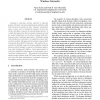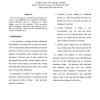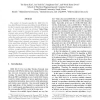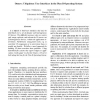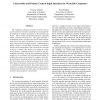PERCOM
2006
ACM
14 years 11 months ago
2006
ACM
PERCOM
2006
ACM
14 years 11 months ago
2006
ACM
In this paper we present a new framework for specifying access control policies in smart spaces called Criticality-Aware Access Control (CAAC). The main idea is to automatically r...
PERCOM
2006
ACM
14 years 11 months ago
2006
ACM
The purpose of this study was to explore the convenient timing for information notification of the users in their daily life. Using the location and the time interval since a loca...
PERCOM
2006
ACM
14 years 11 months ago
2006
ACM
Routing in multi-hop wireless networks is typically greedy, with every connection attempting to establish a path that minimizes its number of hops. However, interference plays a m...
PERCOM
2006
ACM
14 years 11 months ago
2006
ACM
We have developed a method of measuring user interest and affiliation for conference attendees, using behavioral data to collected by `smart badges' worn by the attendees. Th...
PERCOM
2006
ACM
14 years 11 months ago
2006
ACM
The number of channels specified for IEEE 802.15.4 Low-Rate Wireless Personal Area Networks (LR-WPANs) is too few to operate many applications of WPANs in the same area. To overco...
PERCOM
2006
ACM
14 years 11 months ago
2006
ACM
Opportunistic augmentation denotes connecting a personal mobile device to another device to gain a transient advantage for the user. For example, a mobile phone user might borrow ...
PERCOM
2006
ACM
14 years 11 months ago
2006
ACM
The conventional approach for building pervasive environments relies on middleware to integrate different systems. Instead, we have built a system that can deal with these environ...
PERCOM
2006
ACM
14 years 11 months ago
2006
ACM
It is difficult to build user interfaces that must be distributed over a set of dynamic and heterogeneous I/O devices. This difficulty increases when we want to split, merge, repl...
PERCOM
2006
ACM
14 years 11 months ago
2006
ACM
The widespread adoption of mobile electronic devices and the advent of wearable computing has encouraged the development of compact alternatives to the keyboard and mouse. These i...

